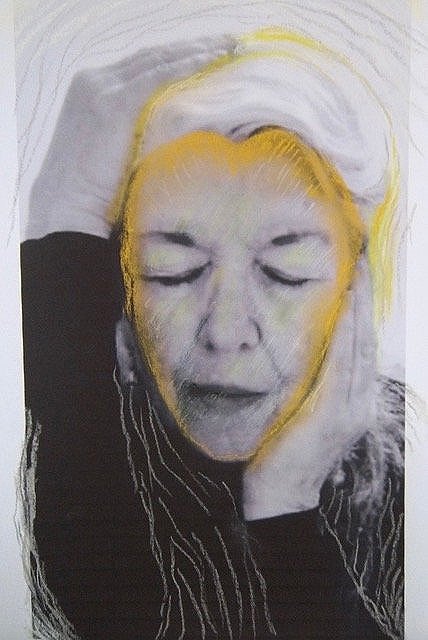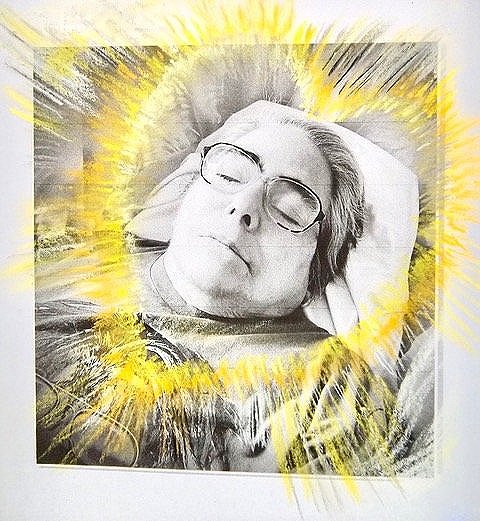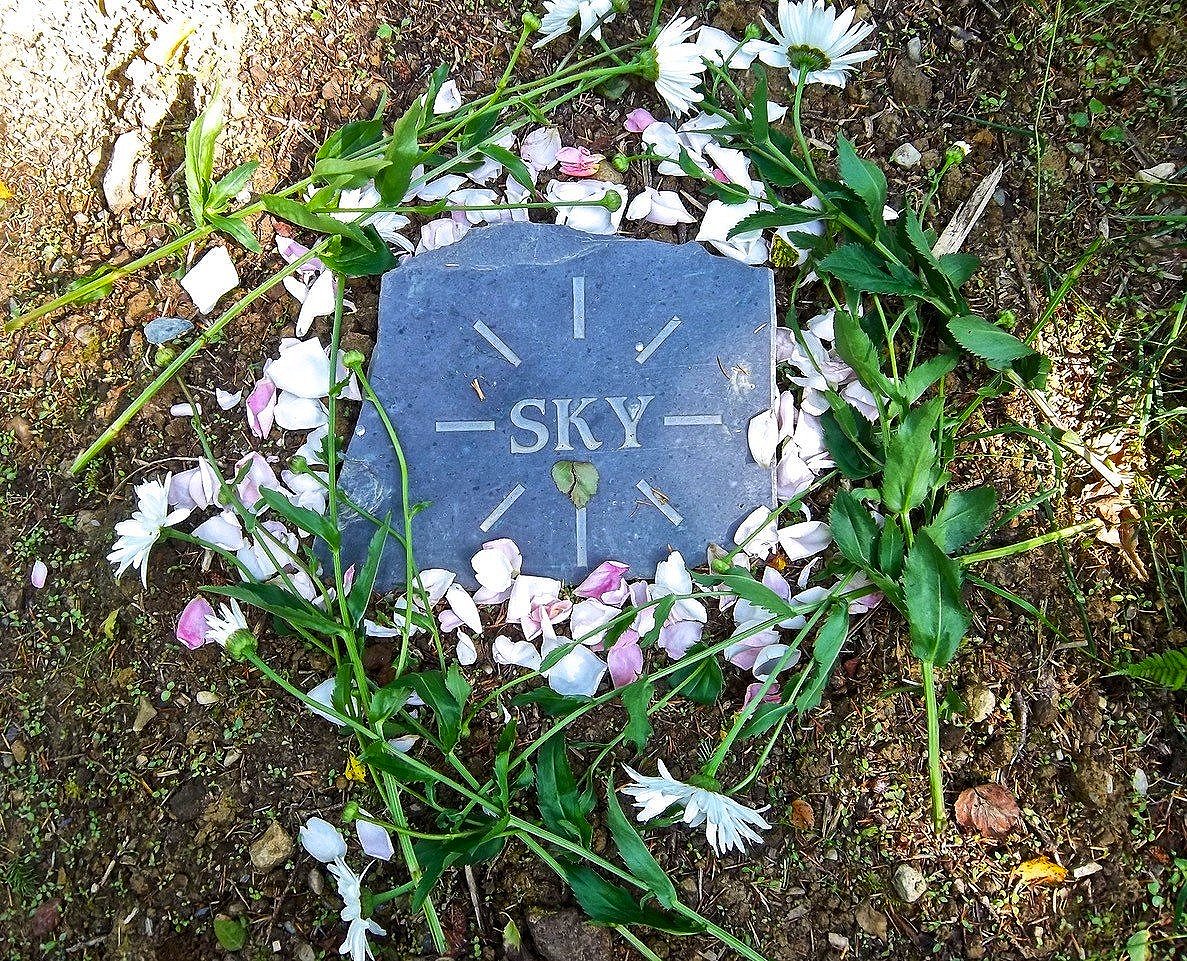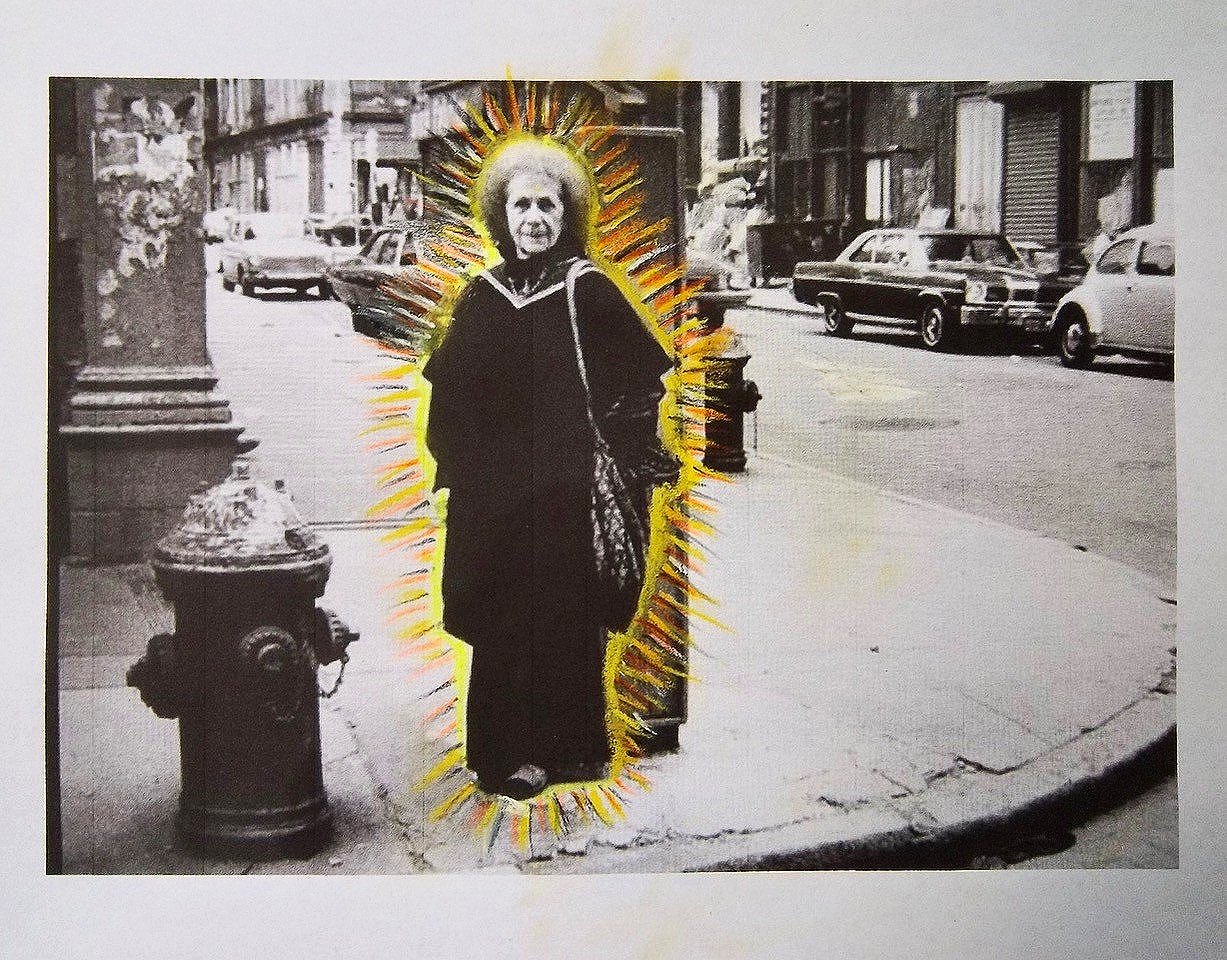Elizabeth Munro
Nicolás Dumit Estévez Raful Espejo: I would like to start this conversation by thanking Linda Mary Montano for introducing us and for teaching me the art of asking questions and listening. How are you today, at this moment? I am asking this from a “speaking truth” approach that I have been learning from Insight Dialogue Meditation. I can share that I am getting more settled as the day continues to flow. I am enjoying the rays of the sun. I am feeling grateful for the bowl of cereal with almond milk I just had. My heart is open to life and I am full of active hope. What about you? Where are you now, Liz? You can interpret this inquiry in any way that makes sense to you.
Elizabeth Munro: I am sitting in front of my computer with tears on my face. I am grieving. I’m grieving for the people of Ukraine, and for Sky and Dianne, my longtime friends, who have recently died. Memories are awakened of WW II: the nightmares are real again with flashbacks to the air raid shelters (this time with shots of people crammed into the metro in the Ukraine). I’m now seeing it all as an adult and realising more fully what it was like for my parents.
NDERE: Can you tell me about your studio-based art process? Can you tell me as well about your life practice?
EM: Today I’ve continued to shred Sky’s papers, and many memories of our times together came to me–she is gone, she is gone…. I’m sitting within this immense grieving and love–for all the people of our world. Those alive and those who have died…immersed in “the deep river of the soul” as Karla McLaren describes grieving. I pray to have the strength to let it flow through me, to respect its power, and to go where it takes me.
NDERE: One point connecting us has been our ongoing conversation about death. As you mentioned, your partner Sky recently died and you have kindly shared images of your experience walking this path. I do not have a question, so I will leave the space open for you to step in.
EM: Sky had a severe stroke in 2017 and I was her carer, until she needed care 24 hours a day…. it had become too dangerous for her to live here, at home, she was falling down and I couldn’t lift her. This was right before Covid began. She went into a good care home near here with kind caring people. We couldn’t see each other in person because of Covid; we talked on the phone and Skyped a lot. Then she was admitted to hospital for what we were told was a minor problem, but I got a shocking call from a doctor who said she had inoperable colon cancer, that other organs were failing and that she was deteriorating rapidly. She died two weeks later–last April 23rd, 2021. By a miracle Megan, a wonderful nurse on the ward, managed to hook up my son Jake (in the U.S.), myself, and Sky on the phone so she could hear us both and we could hear her breathing. We both spoke to her for more than an hour:
“You’re safe
You're free
We’re together
Forever.”
And then we heard Megan say quietly “She slipped away.” It was a beautiful and peaceful experience. It’s comforting to know she had a good death, and that she is buried in a beautiful woodland, Boduan Wood, owned by The Eternal Forest Trust in North Wales. Within the last eleven months I have experienced the dying of two loved ones who were very close to me. It is changing me in such profound ways. I am unable to put it into words: all is in flux, and ‘I' am carried along…
NDERE: With a few exceptions (Linda Mary Montano, Mary Ting, Martha Wilson, Hannah Wilke, Billy X. Curmano…) there has been a tendency in the arts to hide death, aging, illness… These are not glamorous subjects to display in a gallery or to pitch to collectors as potential artwork to hang in their parlors. You are not making art of death and grief yet, your training as a creative might have been informing you as to how to deal with these aspects of life. What would you say about this?
EM: In our society and upbringing it has in the past been taboo to express our painful feelings in general, or to at least keep them minimised. In my childhood I had no vocabulary nor encouragement to communicate my own sexual abuse: the ignorance and lack of education around this subject was indeed tragic. As with the deep feelings of grief around the illness and dying of our loved ones, it is so important to share our feelings with receptive people. Then we can feel that we are not alone in an uncaring universe. This is immensely healing, we are able to feel ourselves to be an integral part of this amazing Life, and we can open ourselves up not only to others but to our own inner selves and Nature herself..
My chosen creative field had been painting, which enabled me to stay in touch with my body energy, after my abuse, by becoming an “action painter”…………although I did not consciously realise it at the time, it was a lifeline that helped me survive without separating and splitting even further within my soul and psyche (which would have then affected my bodily health and wreaked yet more damage). Directly after Sky’s death I performed a “Phowa” ceremony for her. This is a Tibetan Buddhist ritual. I quote from The Tibetan Book of Living and Dying by Sogyal Rinpoche, “Imagine tremendous rays of light emanating from the buddhas or divine beings, pouring down all their compassion and blessing. Imagine this light streaming down onto the dead person, totally purifying and freeing them, granting them profound, lasting peace. Imagine then, with all your heart and mind, that the dead person dissolves into light and his or her consciousness, healed now and free of all suffering, soars up to merge indissolubly and forever, with the wisdom mind of the buddhas.” Inspired by this, and since the recent dying of another close friend, I am expressing my love, and the need to see healing, by creating a series I call Healing Light. I draw healing rays of light around images of loved ones, both living and dead. I also create healing rays around images of myself for self-healing. …..I will see where it takes me….
NDERE: Saint Elisabeth Kübler-Ross matroness saint of death and dying, comes to my mind-heart as I am listening to you. Elisabeth was the doctor who had people spit on her face at her workplace for daring to take the medical institution to task and to speak the unspeakable, the D word. What is the wisdom that you may be harvesting from the visits of death, dying and grief?
EM: I am deeply grateful to Saint Elisabeth Kübler-Ross for her ground-breaking work in speaking so eloquently about death and dying. This has pried open the cages that have imprisoned us in silence for so very, very, long. I am now in the midst of a seismic change that has resulted from the deaths of my loved ones during this time of the Coronavirus pandemic. Also, my early childhood traumas from WW II are being revisited by the tragic war in the Ukraine. I am experiencing tremendous soul expansion and waves of extreme emotion, and aim to stay centred as much as possible during this time, while allowing these energies to move through me…
NDERE: Can we talk about roses? I read somewhere, I wish I could remember where, that a Rose is not longer a Rose is a Rose is a Rose, but a Rose is an Apple. Gertrude Stein would have had such a blast reading this, I think. Maybe not. You and I discussed roses as you were building a grave for Sky and bringing offerings to this sacred site. What in your world is a Rose?
EM: When I was young, I read a lot of fairy tales, one I loved was when the Prince rescued the Princess by cutting through tangled thorny masses of branches to get to her.... I always imagined these to be thorny wild roses that were themselves protecting her, to be breached only by the Prince who would save her life, waking her from an evil spell. Yesterday I came across a piece of writing from years ago that I had written after my mother’s death, I remembered holding her frail birdlike body the last time I was with her, her white hair so fine, so soft on my cheek. I cradled her gently in my mind and spoke to her: “I shower you with soft rose petals and surround you with the scent of lavender fields, the sounds of the birdsongs of early spring…” For me roses have always been magical. I grow them in my garden and their presence and perfume is important to me. At Sky’s burial, I sprinkled rose petals on the earth around her marker for their delicate yet strong transformative power.
NDERE: I very much resonate with the image of grief as a stream where I can or, sometimes, have to dive in. Like you, I read about this in Karla McClaren’s The Language of Emotions. She talks about how one of the gifts of grief is, “complete immersion in the river of All souls.” I am listening to you with no question in mind.
EM: I do indeed experience grieving as intense waves of emotion that sweep over and through me and I have stopped resisting them. I allow my tears to fall as they will and that river can feel so endlessly deep and wrenching. I encourage myself to feel it all. Karla McLaren sees it as a gift and she helps me experience grief that way.
NDERE: What would be your message to the younger generations of creatives who are practicing at a time when capitalism is at its highest in the arts. Where to “make it” means to sell work for tons of money and to become an overnight star. On the other hand, and counter to this, there is the explosion of healing work in the arts. 40 years ago, creatives like you, Mama Donna Henes, and Linda Mary Montano were pioneering this. 10 years ago, I started my studies on healing with a roster of key teachers in field. Now it seems that half of the arts is involve in healing work. I am remembering a time, when talking about hands-on-healing and praying in the gallery was a big no. I lived through this and dared to engage in these iconoclastic actions because of you, Mama Donna, and Linda having walked the path before me. I pray, and, yes, I do pray, that this healing stage in the arts in not just a momentary trend. Now it is my turn to listen to you.
EM: The word is definitely spreading that sharing and expressing our personal traumas and difficulties are an essential part of the healing process. The wall of silence, separation and inner and outer conflict, is no longer our frightening fate. We can, by recognising and naming our various abuses, dare to trust, and learn how to feel safe. It is our right to feel a valued part of a valued whole. It is worth feeling some pain and fear as we go through this process, and we will learn to let more and more of the pain and fear go as they move through and around us in its cleansing river. Words and images, sounds, performances, all creative acts, indeed all we do, can contribute to our healing.
NDERE: Can you leave us with one image? I am grateful for the friendship that is developing between us. I am complete.
EM: The globe, our world, our beautiful planet. We visualise it, surrounding it with love and healing light.
To listen to Elizabeth Munro’s Yale University Radio interview click HERE
To download a free copy of Healing Light, a publication by Elizabeth Munro, click HERE
All images above courtesy of Elizabeth Munro
Elizabeth Munro was born in London of Special Ed. teacher parents at the inception of W.W II. One of her earliest memories is of underground piss smelling air raid shelters and as a result of these rude images drawing became a childhood magical world–a world of color, where she drew pictures of herself building sandcastles and dancing, a world unlike the one she inhabited or dreamt about which often pictured herself being chased by Hitler, snakes and vicious dogs. While awake she drew and insisted on art, color and beauty; a positive, life-affirming defense. At six or seven, a disturbing and continuing episode of sexual molestation from a family friend wielded a second blow to her already shattered childhood and so the need for her creations and place of safety in art became even more necessary. Adolescence and high school were confusing, marred by the past, and all she can remember is an interesting facial tick she calls “the silent scream” that neither parents nor teachers picked up on. Art continued as personal salvation. A formal study of art began in the late fifties at Leeds College of Art where Munro painted, and later at London University where she did postgraduate work in Art Education. Munro says of this time “I was drawing what was reviewed as Lautrecian line drawings and Turneresque color abstract paintings.” The schism between the world of beauty and reality was glaring and not yet addressed, in fact, it had to wait until much later. In the meantime, Munro came to America and as not only influenced by, but involved in the Judson actions. It was a time of no fixed boundaries, a 360-degree viewing, the introduction of multimedia into the scene. A time of no prescribed results, of joining in each others’ pieces–a time of dynamic austerity. Munro’s influences and collaborators were Arlene Rothlein, Malcolm Goldstein, Elaine Summers, Carolee Schneeman, Philip Corner, Yvonne Rainer, and little by little, herself… She left the scene for marriage, motherhood and eventually moved to Woodstock where her current art/life fusion has flowered. Eventually her home became more and more an extension of the canvas, a living shrine and testimony to the power of talismans, rituals, and magical symbols to ward off memory and transform nightmares. No longer was there a need to relegate beauty or art to a gallery, two-dimensional surface or a time frame. For Munro art does not begin or end.
Her dedication to the process, to the dream of beauty, stirs in everyone who enters her home, the same delight she must have felt at four, creating magic on paper to ward off Hitler dreams. And so, when we go for a haircut, cup of tea or visit to Elizabeth’s it’s a Lifeart event that stimulates senses and mind because, now that she has confronted her demons head-on (in 1985 Munro became active in incest survivors’ groups and works on the issue to this day), the experience of beauty has been wed to truth. As a results haircut turns into counseling, turns into trying on hats, turns into watching a re-run of an Oprah Winfrey show on incest, turns into hanging hair on the magic tree that seems to be eternally celebrating Christmas in her living room, and all of that might end in the garden where Turner color abstracts have now become living breathing flowers. Munro says of this time “Once I was able to root out the early violence and then address my own inner violence, I found that gardening became the vehicle that grounded me. I tend the flowers, nurturing them and learning what they need so they can flourish. I have spiraled into an interesting innocence because in nature there are no nightmares, there are lightning storms and earthquakes and nature never judges. It’s the judging, the good/bad stuff that makes for nightmares.” Elizabeth Munro, artist and educator, tends to and sits in her garden, and when the nightmares come they are merely thunder and lightning storms that energise, transform and pass over her life, this time without judgment. Her colours are no longer a child’s escape from pain-rather they are her preferred way to celebrate radiance. It is up to you, reader, to fill in Munro’s biography. She does not use the Media or her past art history connections to further her career or her visibility. This private aspect of her personality is her gift to the commercial art world. While everyone else clamours to be seen and be great, Munro sees and is great. Munro continues her art/life dialogue, private performance, healing salon wherever she goes, whatever she is doing. Her touch is obvious, warm and always lyrically aesthetic, whether it is in New York, London, Brittany or Wales; a conversation among friends, or a painting or drawing in her studio. The style is unmistakable, the feel dreamlike/surreal; the motivation–one of flight and a deep smile at and with life’s mysteries. Art has no end, nor does love.
Biography of Elizabeth Munro written by Linda Mary Montano





